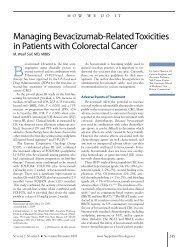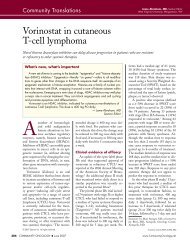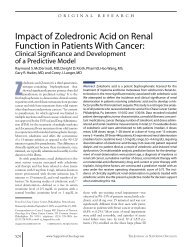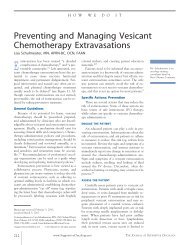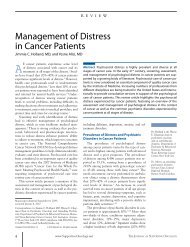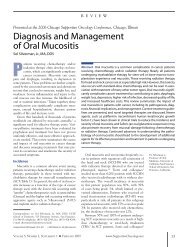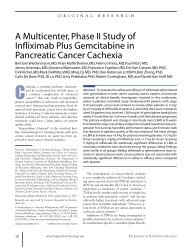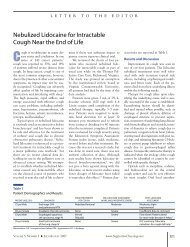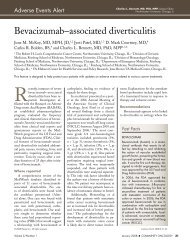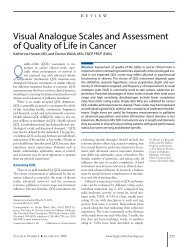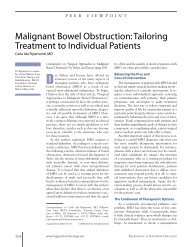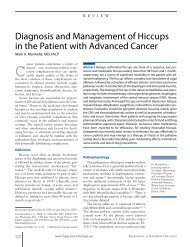Volume 9 Number 3 March 2012 - Oncology Practice Digital Network
Volume 9 Number 3 March 2012 - Oncology Practice Digital Network
Volume 9 Number 3 March 2012 - Oncology Practice Digital Network
Create successful ePaper yourself
Turn your PDF publications into a flip-book with our unique Google optimized e-Paper software.
Review<br />
No<br />
Assess Baseline Characteristics & Pre-existing Arthralgia<br />
– Other medications (eg, statins, antihypertensive)<br />
– Obesity, body mass index > 30<br />
– Depression<br />
– Social history<br />
– Pre-existing (rheumatologic diagnosis, carpal tunnel syndrome,<br />
morning stiffness, and arthralgia complaint)<br />
1. Baseline exam<br />
2. Education<br />
3. Vitamin D (monitor and replete if low)<br />
Initiate Aromatase Inhibitor Therapy<br />
New or Worsening Arthralgia Symptoms<br />
•Consider switching to tamoxifen if appropriate<br />
•Re-address baseline risk for intervention<br />
•Exam: joints and grip strength b<br />
•Hypothyroid: TSH<br />
Arthralgia Management<br />
1. Baseline exam<br />
2. Education<br />
3. Vitamin D (monitor and replete if low)<br />
4. Diet<br />
5. Exercise (eg, yoga, stretching)<br />
6. Antidepressants, stress management<br />
7. Anti-inflammatories<br />
8. Refer to rheumatologist, if appropriate a<br />
thralgia symptoms during AI treatment have not been<br />
formally studied; they have been extrapolated from the<br />
current management of arthritis and other related entities.<br />
Treatment of MSS symptoms should be individualized<br />
based on symptoms, differential diagnoses, and concomitant<br />
therapies. Furthermore, arthralgia symptoms could be an<br />
early sign of rheumatoid arthritis, requiring referral to a<br />
rheumatologist (Figure 2). 53<br />
Published recommendations from experts in the field<br />
and an arthralgia working group for the management of<br />
arthralgia symptoms in patients receiving AI therapy suggest<br />
a sequential use of lifestyle changes and pharmacologic<br />
interventions, depending on symptom severity (Figure<br />
2). 6,15 The recommendations also stress patient<br />
Yes<br />
• Behavior modification: diet, exercise, and stress reduction<br />
• Pharmacologic: anti-inflammatory c<br />
• Complementary treatments: acupuncture, TENS, patellar taping, biofeedback, and/or probiotics<br />
• Trial wash-out and switch to another aromatase inhibitor<br />
FIGURE 2 Algorithm for diagnosis and management of AI-associated arthralgia. TSH indicates<br />
thyroid-stimulating hormone; TENS indicates transcutaneous electrical nerve stimulation. a Criteria for<br />
referral include 3 swollen joints, metatarso-/metacarpophalangeal involvement, and morning<br />
stiffness that lasts 30 minutes. b Joint examination is for absence of effusion and pain (mild tenderness<br />
permissible), with no associated joint changes (if positive, refer to rheumatologist); grip strength should<br />
be normal. c Treatment is with a nonsteroidal anti-inflammatory agent, ibuprofen, naproxen, or diclofenac,<br />
or a cyclo-oxygenase-2–specific inhibitor such as celecoxib, if not contraindicated.<br />
counseling and education as important<br />
components of arthralgia management.<br />
Advising patients that arthralgia<br />
is common with AI<br />
treatment—and that symptoms can<br />
be managed—may increase the likelihood<br />
that patients will report these<br />
events. This, in turn, promotes appropriate<br />
symptom management and<br />
discourages AI therapy discontinuation<br />
or nonadherence.<br />
Lifestyle changes—including dietary<br />
changes, weight loss, and<br />
exercise—are suggested for patients<br />
with either preexisting or new-onset<br />
symptoms. 15 Weight loss may decrease<br />
the risk for joint symptoms, as<br />
obese women (BMI 30 kg/m 2 )in<br />
the ATAC study were more likely to<br />
report joint symptoms than were overweight<br />
or normal-weight women<br />
(BMI 30). 17 In a prospective<br />
study of tenosynovial changes in patients<br />
who were treated with an AI or<br />
tamoxifen, a regression analysis suggested<br />
that grip strength decreased<br />
more for patients with high or low<br />
body mass index (BMI). 57 Yoga, exercise<br />
(especially weight-bearing exercise)<br />
with regular stretching, and<br />
physical therapy with joint-mobility<br />
exercises have been suggested for<br />
the management of mild arthralgia<br />
pain. 5,53,58 Such measures may also<br />
support breast cancer treatment<br />
goals, for example, in patients without<br />
hot flashes who were effectively<br />
treated for breast cancer, dietary<br />
changes that were maintained over 4 years were also<br />
shown to reduce the risk of breast cancer. 59 Exercise<br />
may also contribute to improved survival after adjuvant<br />
breast cancer treatment. 60 Other nonpharmacologic<br />
approaches to MSS management include heat (eg, hot<br />
packs), footwear with lateral-wedge insoles (for kneeassociated<br />
symptoms), massage therapy, and acupressure<br />
(Figure 2). 5,6,53<br />
Pharmacologic treatment options for AI-associated arthralgia<br />
that reportedly provide symptom relief include<br />
conventional NSAIDs (eg, ibuprofen), 11,16 analgesics (eg,<br />
acetaminophen), 16 coxibs (eg, celecoxib), tramadol, glucosamine<br />
plus chondroitin sulfate, 16 opioids, 16 probiotics<br />
98 COMMUNITY ONCOLOGY <strong>March</strong> <strong>2012</strong> www.Community<strong>Oncology</strong>.net



